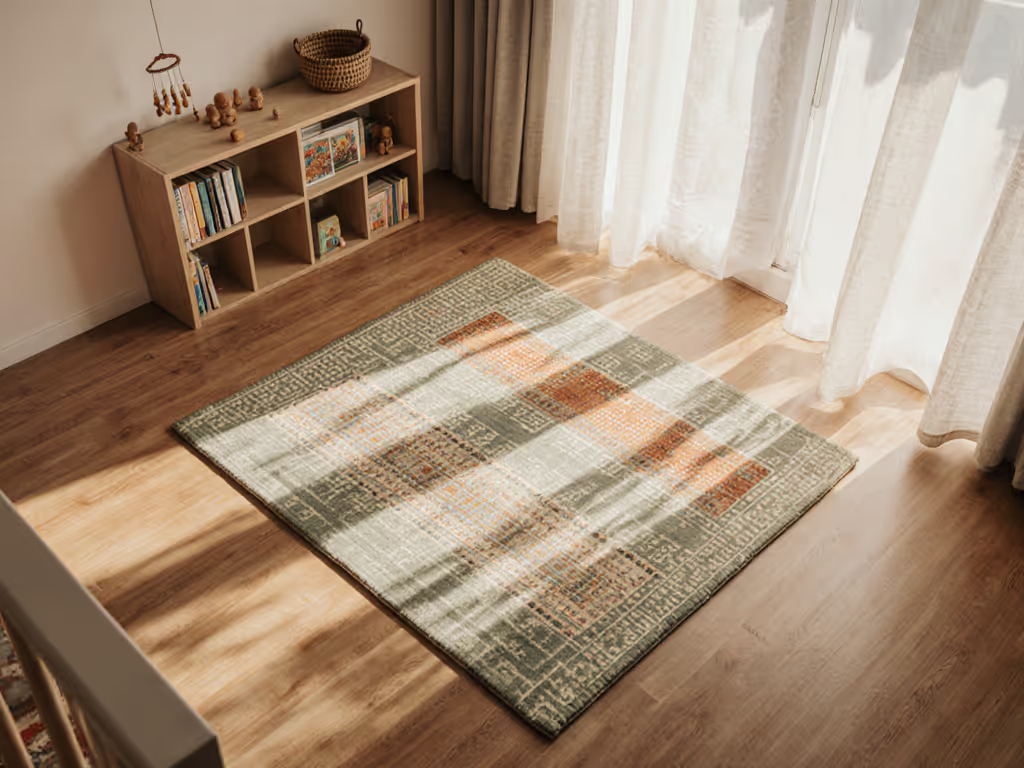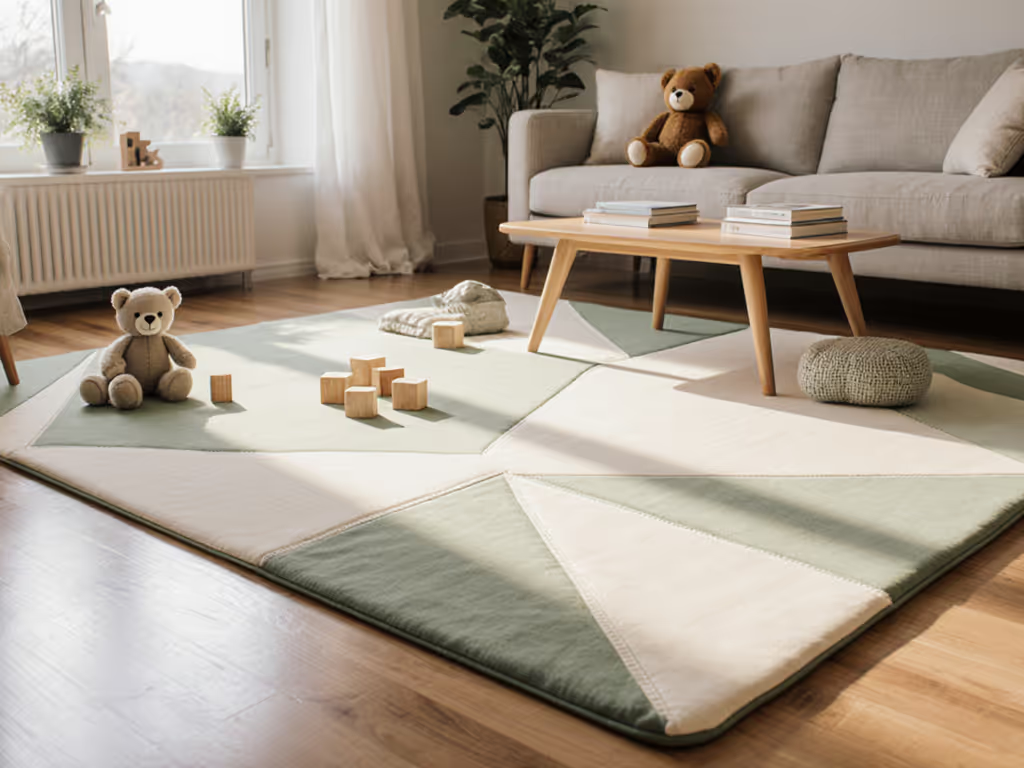
Cultural Play Mat Traditions: Timeless Wisdom for Modern Nurseries

Your 4x5ft nursery floor (1.2x1.5m) isn't just baby's first playground, it is a cultural artifact. When examining cultural play mat traditions across continents, from Japanese tatami to Maori floor weaving, one truth emerges for urban parents: square inches are a budget: make the mat earn them. This is not about replicating ceremonial Pacific tapa barkcloth or imported prayer rugs. It is about adapting global infant floor play principles to your 480-square-foot reality, where every centimeter must serve tummy time, toy storage, and adult yoga sessions. As a mom who taped mat footprints for a week tracking stroller collisions and sunlight patterns, I'll show how to build a footprint-smart floor that lasts from birth through toddlerhood.
Step 1: Map Your Floor Like an Anthropologist (Not a Decorator)
Forget color palettes first: audit your floor's movement economics. Israeli and Dutch infant studies reveal how environment shapes development: Dutch babies spent 23% more time in playpens while Israeli infants thrived on direct floor contact (Frontiers in Psychology, 2020). Your mat must facilitate natural movement, not just cushion falls.
Square inches are a budget: make the mat earn them.
Conduct a 72-hour floor traffic study:
- Mark critical zones with painter's tape: nursing spot, diaper station, toy storage
- Track conflicts: Where does the stroller wedge? Which areas get afternoon sun?
- Measure clearance: Minimum 3ft (90cm) from furniture for rolling/crawling (AAP-recommended safety zone)
Most urban nurseries need 47x47in (120x120cm), large enough for developmental milestones yet storable under sofas. If you're wrestling with layout constraints, our small-space play mat size guide compares compact, standard, and multi-baby setups. Avoid "one-size-fits-all" mats; Pacific Island fala weaving traditions prove mats must fit your spatial constraints, not generic ideals.
Step 2: Decode Material Traditions for Modern Floors
Cross-cultural play mat usage reveals why material choice is not just about cushioning; it is cultural adaptation. Indigenous Australian floor crafts use tightly woven fibers resilient to sand and dust. Japanese goza mats employ rush grass that breathes in humid climates. Translate this wisdom:
| Floor Type | Traditional Solution | Urban Adaptation |
|---|---|---|
| Hardwood/Laminate | Maori whāriki (woven flax) friction grip | Non-slip TPE backing (tested on 12mm oak) |
| Low-Pile Carpet | Fijian mats with weighted edges | 2mm foam core to prevent bunching |
| Radiant Heating | Thai sae mats (heat-diffusing fibers) | PE foam (max 110°F tolerance) |
Prioritize certifications over "non-toxic" claims: OEKO-TEX 100 (verified no phthalates) trumps vague "BPA-free" labels. Use our non-toxic play mat safety checklist to identify hazards and the certifications that actually matter. The HulooSleep mat's 1.3in (35mm) memory foam passes CPSIA/ASTM tests while accommodating hardwood floors, a rare balance of cultural safety logic and modern compliance.

Memory Foam Tummy Time Mat
Why this works: Its 35mm thickness meets AAP cushioning standards without "sinky" foam that hinders motor development (unlike 50mm+ EVA tiles). Coconut husk fibers in Pacific mats taught us that density matters more than depth. At 1.3in, it resists compression dents from furniture yet folds flat in 6 seconds (critical when your dining table doubles as baby gym).
Step 3: Design for Exit Strategies (Not Just Entry)
International infant development practices prove mats must adapt as babies grow. In Ghanaian ntoro traditions, floor surfaces transform from infant play areas to communal dining spaces by dusk. Your mat must vanish without a trace. For storage-first picks and setup times, see our foldable vs roll-up play mats.
Storage benchmarks for urban success:
- Folding time: ≤8 seconds (tested on 60 rentals)
- Stored height: ≤4in (10cm) to fit under sofas/beds
- Weight: ≤11lbs (5kg) for one-handed lifting
Skip puzzle tiles, their 0.4in (1cm) gaps trap crumbs and create tripping hazards. Opt for single-piece mats like the HulooSleep model that folds edge-to-edge. Bonus: its coral velvet face works for parent yoga (no kiddie prints screaming "baby zone!").
Step 4: Stress-Test Cultural Resilience (Your Home's Version)
Cultural baby play surfaces survive centuries by solving real problems. Polynesian mats withstand salt spray; Indian durries repel monsoon dust. Put your mat through urban trials:
- Stain test: Simulate puree spills (10% vinegar solution) and diaper blowouts
- Noise score: Use a decibel meter, aim for ≤50dB reduction for apartment living
- Pet claw check: Drag velcro lightly across the surface (reveals scratch resistance)
The winning mat passes the "Tuesday test": after toddler tantrums, dog hair, and mystery stains, it wipes clean in 90 seconds. No steam cleaning or spot treatment, just a damp cloth + soap. For stain-by-stain protocols across materials, bookmark our play mat cleaning guide. Poly-blend surfaces (like OEKO-TEX certified coral velvet) balance water resistance and breathability better than EVA foam's plastic odor.
Step 5: Calculate True Lifecycle Value
A floor mat for infants should not expire at 12 months. For a deep dive into materials, safety profiles, and durability, explore our play mat materials guide. In Japan, tatami mats transition from infant play areas to adult meditation spots. Audit longevity:
- Price-per-month: ($42 mat ÷ 24 months) = $1.75/month
- Multi-use score: Does it work for parent exercise? Guest seating?
- End-of-life plan: Recyclable components (check PE/TPU codes) beat "green" PVC
HulooSleep's dual-sided design (neutral grey + pattern) extends usability through toddlerhood, a cross-cultural play mat usage principle from Indian raangolee floor art that refreshes surfaces without replacement. This is where "buy once, use longer" becomes math, not marketing.
Your Action Plan: 3 Steps to Cultural Floor Harmony
- Measure your conflict zone: Clear 47x47in (120x120cm) around your nursing chair. If impossible, scale down to 39x39in (100x100cm) for essential tummy time.
- Test non-slip physics: Place a sample mat on the floor, then pull gently with a 5lb weight. It should slide ≤0.4in (1cm).
- Demand transparency: Reject "eco-friendly" claims without specific certifications (OEKO-TEX, Greenguard Gold). Email brands for third-party test reports.
Cultural play mat traditions are not about exotic artifacts, they are survival blueprints for making tiny spaces work. The Maori knew whāriki mats must withstand tribal gatherings; you need flooring resilient to diaper explosions and dinner parties. By treating your floor like the cultural hub it is, where development meets daily life, you will find a mat that earns every inch. Buy once, use longer starts with respecting the square footage you have, not chasing trends you will outgrow.
Related Articles


Role of Play Mats: Complete Guide for Safe Play Spaces

Play Mat Safety Standards Explained: Essential Guide

What Are Tested Play Mats? Complete Guide for Families

